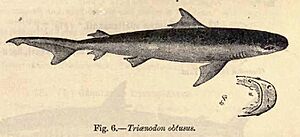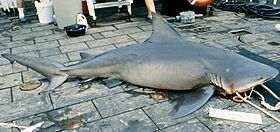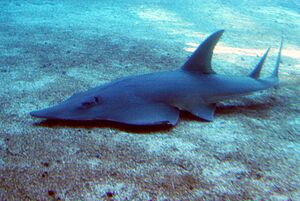Pigeye shark facts for kids
Quick facts for kids Pigeye shark |
|
|---|---|
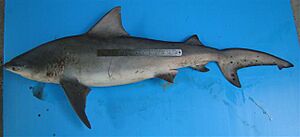 |
|
| Conservation status | |
| Scientific classification | |
| Genus: |
Carcharhinus
|
| Species: |
amboinensis
|
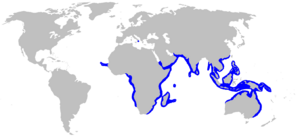 |
|
| Range of the pigeye shark | |
| Synonyms | |
|
Carcharias amboinensis Müller & Henle, 1839 |
|
The pigeye shark, also called the Java shark (Carcharhinus amboinensis), is a type of requiem shark. It lives in warm coastal waters of the eastern Atlantic Ocean and western Indo-Pacific region. This shark prefers shallow, murky places with soft, muddy bottoms. It usually stays in a small area.
With its strong grey body, small eyes, and short, blunt snout, the pigeye shark looks very much like the more famous bull shark (C. leucas). People often confuse them! These two shark species are different in how many vertebrae (backbones) they have. They also differ in the size of their dorsal fins (the fins on their back) and other small features. A typical pigeye shark grows to be about 1.9–2.5 m (6.2–8.2 ft) long.
The pigeye shark is a top hunter in its environment. It mostly hunts for food near the sea floor. It eats many different things, like bony and cartilaginous fishes (like other sharks and rays). It also eats crustaceans (like crabs), molluscs (like squid), sea snakes, and even cetaceans (like dolphins).
This shark gives birth to live young, just like humans do. The baby sharks grow inside their mother, connected by a special placenta that gives them food. Mothers give birth to three to thirteen pups after being pregnant for nine to twelve months. Young sharks stay in safe, shallow areas like bays for their first few years. Their movements here follow the tides and seasons. The pigeye shark is large and has strong teeth, so it could be dangerous. However, it has never been known to attack humans. People sometimes catch these sharks in shark nets near beaches or by fisheries. They are used for meat and fins. The IUCN says this shark is a vulnerable species.
Contents
About the Pigeye Shark
Naming the Pigeye Shark
Two German scientists, Johannes Müller and Jakob Henle, first described the pigeye shark in 1839. They named it Carcharias (Prionodon) amboinensis. Later, other scientists put it in the shark genus called Carcharhinus.
The first pigeye shark they studied was a stuffed female shark. It was 74 cm (29 in) long and caught near Ambon Island in Indonesia. This island is where the shark's scientific name, amboinensis, comes from. Over time, this shark has been given other names that are now considered synonyms (different names for the same species). One of these was Triaenodon obtusus.
Where Pigeye Sharks Live
The pigeye shark lives in many places around the world. It is found in the tropical and subtropical waters of Eurasia, Africa, and Oceania. However, it does not seem to be very common anywhere. It might be hard to know its full range because it looks so much like the bull shark.
In the eastern Atlantic, you can find it near Cape Verde and Senegal. It also lives from Nigeria to Namibia. There has been one sighting in the Mediterranean Sea near Crotone, Italy. It lives all along the edge of the Indian Ocean. This includes eastern South Africa, the Arabian Peninsula, Madagascar, the Seychelles, and Mauritius. It is also found in Southeast Asia and northern Australia. Its home range goes into the Pacific Ocean, north to the Philippines and southern China. It also reaches New Guinea and some islands in Micronesia.
Studies show that pigeye sharks, especially young ones, do not travel far. They tend to stay in one local area. The farthest an adult shark has been recorded traveling is 1,080 km (670 mi).
Pigeye Shark Homes
Pigeye sharks live in coastal waters, as deep as 150 m (490 ft). They like places with fine sediment (like sand or mud) and murky water. Sometimes, they go into estuaries (where rivers meet the sea). But unlike bull sharks, they do not swim up rivers and avoid brackish water (water that is a mix of fresh and salt).
Young pigeye sharks have been studied a lot in Cleveland Bay in northeastern Queensland, Australia. These young sharks live in the bay all year. They mostly stay on the eastern side where three rivers flow in. This creates strong currents and cloudy water. Each young shark has a fairly small home area, about 30 km2 (12 sq mi) on average. This area gets bigger as the shark gets older.
Young sharks usually stay in water less than 40 m (130 ft) deep. The youngest sharks spend the most time in the shallowest parts of the bay. They swim into the intertidal zone (the area between high and low tide) when the tide comes in. They leave as the tide goes out. This movement might help them find food on the muddy areas that get covered by water. Or it might help them avoid bigger sharks that live in deeper waters.
There is also a yearly movement pattern. Young sharks move closer to river mouths during the dry season. They move farther away during the wet season. The rainy season brings more fresh water into the bay. So, the sharks might be reacting to less salt and oxygen in the water.
What Pigeye Sharks Look Like
The pigeye shark has a very strong body. Its snout (nose area) is short, wide, and rounded. Its eyes are small and round, and they have special eyelids called nictitating membranes. The front edges of its nostrils have medium-sized skin flaps. Its mouth is wide and has small grooves at the corners.
It has 11–13 (usually 12) rows of teeth on each side of its upper jaw. It has 10–12 (usually 11) rows of teeth on each side of its lower jaw. There are also single rows of tiny teeth in the middle of both jaws. The teeth are wide and triangular with jagged edges. The lower jaw teeth are a bit narrower and straighter than the upper ones. The shark has five pairs of gill slits that are a medium length.
The first dorsal fin (on its back) is large and shaped like a triangle. It has a pointed top and a curved back edge. It starts above where the pectoral fins (side fins) are attached. The second dorsal fin is less than one-third the height of the first one. It starts in front of the anal fin (fin near the tail). There is no ridge on its back between the dorsal fins. The long pectoral fins are wide and slightly curved like a sickle. They become narrow and pointed at the tips. The anal fin has a sharp notch on its back edge.
The caudal peduncle (the narrow part before the tail) has a deep notch on its top side. This is where the caudal fin (tail fin) begins. The tail fin is not symmetrical. It has a well-developed lower part and a longer upper part. The upper part has a notch near its tip.
The shark's skin is covered in large, rough scales called dermal denticles. These scales become more tightly packed as the shark gets older. Each scale has three to five horizontal ridges and five teeth at the back. The shark is grey on top and white underneath. It has a faint pale band on its sides. The tips of the second dorsal fin and the lower tail fin get darker, especially in young sharks. An albino (all white) pigeye shark was found in Queensland in 1987. This was the first time an albino requiem shark was seen. An adult pigeye shark is usually 1.9–2.5 m (6.2–8.2 ft) long. The biggest ones can reach 2.8 m (9.2 ft) long.
You can best tell a pigeye shark from a bull shark by counting their vertebrae before the tail fin. Pigeye sharks have 89–95, while bull sharks have 101–123. Also, the pigeye shark's first dorsal fin is much taller than its second (more than 3.1 times taller). For bull sharks, it's less than or equal to 3.1 times taller. The notch in the pigeye shark's anal fin forms a sharp angle, but in bull sharks, it forms a right angle. Pigeye sharks also usually have fewer tooth rows in their lower jaw (10–12 on each side) than bull sharks (12–13).
Pigeye Shark Behavior
Social Life and Predators
The pigeye shark is mostly a lonely animal. However, sometimes several sharks can be found in the same place. In the Mozambique Channel, there are more pigeye sharks on the east side and more bull sharks on the west side. This might mean these two similar species compete for space.
Young pigeye sharks can be eaten by bigger sharks. Studies in Cleveland Bay show that only about 5% of young sharks die each year. This is similar to young bull sharks. It is much lower than for young blacktip sharks (C. limbatus) or lemon sharks (Negaprion brevirostris).
What Pigeye Sharks Eat
Even though the pigeye shark can catch food anywhere in the water, it usually hunts near the sea floor. As a top hunter, it mainly eats teleost fishes. These include croakers, flatfishes, and cutlassfishes. It also eats some cartilaginous fishes (like other sharks and rays), cephalopods (like squid), and decapod crustaceans (like crabs).
It has also been seen eating gastropods (like snails), sea snakes, dolphins, and dead whales. Other sharks and rays are a much bigger part of the diet for pigeye sharks in South Africa. The types they eat include requiem sharks, catsharks, angel sharks, guitarfishes, stingrays, and eagle rays.
Pigeye Shark Reproduction and Life Cycle
The pigeye shark gives birth to live young. Like other requiem sharks, the baby shark grows inside its mother. After the baby uses up its yolk supply, it gets food from its mother through a special connection called a placenta. Adult female sharks have one working ovary and two working uteruses.
How they reproduce can be different depending on the region. Off South Africa, the mother is pregnant for about 12 months. Mating and giving birth both happen in late summer. Litters (groups of babies) have three to seven pups (usually five). Newborns are about 75–79 cm (30–31 in) long.
Off northern Australia, the mother is pregnant for 9 months. Births happen in November and December. Litters have six to 13 pups (usually nine). Newborns are about 59–66 cm (23–26 in) long.
Young sharks stay in shallow, safe places like bays until they are at least three years old. This shows that these areas act as nurseries for them. As the sharks get older, they swim farther from land into deeper water more often. Eventually, they spread out. This species lives a long time and grows slowly. Males grow faster but do not get as big as females. Males become adults when they are about 2.1 m (6.9 ft) long and 12 years old. Females become adults when they are about 2.2 m (7.2 ft) long and 13 years old. Males can live for at least 26 years, and females for at least 30 years.
Pigeye Sharks and Humans
The pigeye shark is large and has strong teeth. Because of this, it is seen as possibly dangerous to humans. However, it has not been involved in any known attacks. People sometimes catch this shark using longlines and gillnets. Its meat and fins are used for food.
Since the shark is a predator, it can gather ciguatera toxins in its body. These toxins are made by tiny sea organisms called dinoflagellates. In November 1993, about 500 people in Manakara, Madagascar, got sick after eating pigeye shark meat. Sadly, 98 of them died. This was the first time so many people got food poisoning from a shark.
The IUCN has listed the pigeye shark as vulnerable. This means it is at risk. Its rarity might make it easy to overfish. In KwaZulu-Natal, South Africa, a small number of pigeye sharks are caught in shark nets that protect beaches. The number of sharks caught and their average size decreased between 1978 and 1998. This made people worried that the local population might be getting too small. Because of this, the IUCN has given this species a regional assessment of Near Threatened in the southwestern Indian Ocean.



